INTRODUCTION
The study of seals and sealing practices is the study of representation and identity, of ideas and semiotics, and of administrative and legal developments. Seals can also on occasion provide unique evidence about an individual: the physical record of a person at a particular time and in a particular place, through the impression of hand and fingerprints in wax.Footnote 1 This article utilises such prints, in combination with the impression of seal matrices and written documents relating to St Ethelbert’s Hospital in Hereford, to consider in detail the process of authentication. Through this it looks at the development of bureaucracy, and the ideas and reality of the presence, both immediate and, through the preservation of a sealed instrument, across time, of individuals involved in formalised exchanges in the Middle Ages. The following discussion also contributes to the debates – contemporary, medieval and modern – about the nature of the relationship between the seal matrix and its owner, and to what extent the mediation of the physical act of sealing through a third party was acceptable.
SEALING PRACTICES: AN OVERVIEW
The practice and evidence of sealing was not only a central part of the validation of documents, but also a vital component of the donor’s consent to that grant expressed in tangible form through parchment and wax. Who was involved in the physical act of sealing is an important issue in understanding shifts in administrative practice and individual and institutional perception of the legal status of the document, as well as being part of a broader medieval academic debate around ideas of veracity, representation and identity.
For example, Michael Clanchy, in his seminal study of the shift from proof through oral testimony and symbolic exchanges featuring the transfer of a physical object before witnesses, to the adoption of the written record of such an exchange as proof in its own right, suggests that ‘fixed to a charter, the seal became a relic which could be seen and touched, in order to obtain from it that authentic knowledge of a donor’s wishes which no writing could adequately convey’.Footnote 2
Brigitte Bedos-Rezak’s pioneering work on seals and sealing practices also highlights the centrality of the matrix and impression as expressions of the owner’s will, describing seals as ‘active agents’ and ‘active expressions of their users’, with ‘power of becoming (the impressions) as well as simply of being (the intaglio matrices)’.Footnote 3 Furthermore, Bedos-Rezak, Michael Pastoureau and others have noted the apparent importance, at least during the first couple of centuries of medieval Western European documentary sealing, of the physical contact between the sealer and both the matrix and the wax into which an impression is made.Footnote 4 These are all debates to which this paper can contribute fresh evidence.
The sealing of documents as an integral part of the process of authenticating an exchange or agreement (that is, attaching to a document the impression of a seal matrix which was designed to remain, intact, with the written instrument) has very ancient origins, but there was a marked upsurge in this practice in north-western Europe in the eleventh century.Footnote 5 In medieval Britain, the seal of validation became part of the administrative and legal process in the reign of Edward the Confessor, and by the early twelfth century the secular and ecclesiastical elites, along with a number of religious institutions, were sealing on a regular basis.Footnote 6 During the twelfth and early thirteenth centuries the practice of documentary sealing spread rapidly, both socially and geographically, and by the later thirteenth century there were legal expectations for the sealing of exchanges of free land and property and the granting of substantive rights, and a general enthusiasm for sealing all manner of exchanges and agreements.Footnote 7
The act of sealing – the pressing of a seal matrix into a soft material to create an impression – elicited interest from medieval theologians and philosophers as well as lawyers and bureaucrats, especially when the material was wax.Footnote 8 Before the advent of printing, the potential of a seal matrix, engraved with image and text, to produce multiple impressions that were identical but also unique items in their own right also raised questions about authenticity and replication of authority,Footnote 9 and in pre-scholastic theology the impressing of a matrix into a plastic material was used in discussions of the act of Creation, the matrix of the divine being said to be imprinted into the malleable soul of man.Footnote 10
Despite a considerable amount of writing about, or using, the metaphor of sealing from a theological and philosophical perspective, and injunctions about the use of seals in legal and administrative contexts, there are surprisingly few descriptions of the actual physical act of sealing. In the royal chancery, several offices developed in the twelfth and thirteenth centuries that provide some information about the process in a busy administrative environment, and there are occasional references to the act of documentary sealing in legal records.Footnote 11 Much of our information comes, however, from the physical material, which can be difficult to interpret, or which can seem to call into question general assumptions. By the later thirteenth century the physical practice of sealing seems to have shifted into the realm of an administrative process in many ways, although it is possible that – at least in an English context – there was still an expectation that the sigillant would directly participate in some way, even if only by touching the matrix or withdrawing it from the wax after it had been impressed by an administrator.Footnote 12 A survey of medieval documents at Hereford Cathedral as part of this project has revealed that this process is, however, rather more complex and unpredictable than perhaps has been appreciated. A focus on the back of the wax of pendent seals also demonstrates that a more nuanced approach must be taken when discussing the act of sealing. For example, the idea that the wax was pushed into the matrix and the back then shaped while the matrix was in place is not supported by the evidence, where on many occasions it is clear that the wax cakes must have rested in the palm with the matrix impressed from above.Footnote 13 There are also a number of examples where the impression of the principal matrix is overlaid with handprints in instances when there is the impression of a subsidiary matrix on the back of the wax, again questioning the assumption (and indeed logical conclusion) that the wax remained placed in the main matrix while the subsidiary one was impressed.Footnote 14 An analysis of the findings at Hereford helps us, as we will now show, to better understand both administrative processes and how seals and sealing, with the attendant questions of representation, identity, authentication and exercise of authority, actually worked in practice rather than just in theory.
THE PHYSICAL PROCESS OF SEALING: ANALYSING THE EVIDENCE OF HAND- AND FINGERPRINTS
In order to investigate whether it is possible to identify hand- and fingerprints from medieval seals, and to see if the results provide any useful information, a sample of sealed documents from Hereford Cathedral Archives (HCA) was analysed by a forensic identity science expert in conjunction with the authors.Footnote 15 The documents chosen were from the late twelfth to mid-fourteenth centuries, a period of considerable change in administrative and sealing practices.Footnote 16 Out of 220 sealed documents examined for the study, 207 had visible hand- or fingerprints on the wax into which a seal matrix had also been impressed, of which 176 were viable (that is, some form of analysis was possible) and fifty-eight had prints classified as ‘good’.Footnote 17 Fifty-two of these good prints were from palms (most showing a clear distal transverse crease – the crease running horizontally across the upper part of the palm – indicating that the person holding the wax was cupping their hand), three from fingers, one probable finger and two which included prints both from the palm and fingers of the same hand.Footnote 18 The majority of prints were single deposits, with an individual identified only once in the sample, but there were individuals whose prints appear on more than one seal, one of whom handled the wax seals on no fewer than five separate documents. Although it is not always possible to tell if prints are male or female, it seems probable to the forensic expert that these are male prints, lacking the shape of a female palm. It is here that we turn to St Ethelbert’s Hospital in Hereford.
The seals in this case study are attached to a number of land grants and confirmations of the second quarter of the thirteenth century, all in favour of one institution in the English city of Hereford. In the mid-1220s, Elias of Bristol, one of the canons of Hereford Cathedral, founded a hospital, dedicated to St Ethelbert, which is said in contemporary documents to have been both on the fief of William Marshall (presumably Stephen son of Hugh, from whom Elias purchased the land, held it of the earl) and ‘next to the cemetery of St Ethelbert’ that is adjacent to the cathedral.Footnote 19 The detailed chronology of the hospital is uncertain, but there was a building on the site by the 1230s when Master Reginald was described as custos there, with three confratres, or brothers.Footnote 20 By 1252 documentation of the quarrel between the then bishop of Hereford, Peter de Aigueblanche, and St Ethelbert’s included an accusation that they were not providing properly for the 100 poor there, suggesting large numbers of people were seeking alms by that date, although presumably with so few brothers the suppliants were not living on the premises.Footnote 21 Elias, a former royal servant, had dedicated the hospital to the memory of King John as well as placing it under the authority of the Dean and Chapter, and he obtained a number of indulgences for it from bishops across England and Wales.Footnote 22 Elias himself also made additional donations to the hospital from his property in and around Hereford,Footnote 23 and the hospital of St Augustine’s in Bristol – presumably Elias’s home town – also made a grant to the new institution.Footnote 24 The majority of the land the hospital received over the twenty-five years or so after Elias’s foundation (thus, from the mid-1220s) was given in small amounts, however, by landholders in and around Hereford. The documents detailing these gifts and confirmations form a valuable collection, and provide an ideal sample for investigating questions relating to sealing and administrative practices. In particular, the short chronological range and geographically limited nature of the exchanges and parties involved lend themselves to a forensic study of the hand- and fingerprints visible on the wax seals.
THE ST ETHELBERT HOSPITAL COLLECTION: A CASE STUDY OF SEALING PRACTICES
The evidence of the prints on these seals allows us to investigate in particular two different types of cases: those of matching prints from the same individual on more than one wax, and of non-matches where impressions of an identical matrix are linked to several different handprints, revealing the presence of different individuals handling different waxes. Together these tell a story about the development of sealing and administrative practice, and about the seal as an individual’s identity.
The hospital deeds include five documents from this twenty-five year period of c 1225–50 (fig 1a–e), where an individual’s same handprint appears on the reverse of all the wax seals attached, although they are issued in the names of five different grantors: Walter of Lyde Godfrey; John, son of Walter; Hugh, son of Ailmund; William Long; and Osbert, son of Suin.Footnote 25
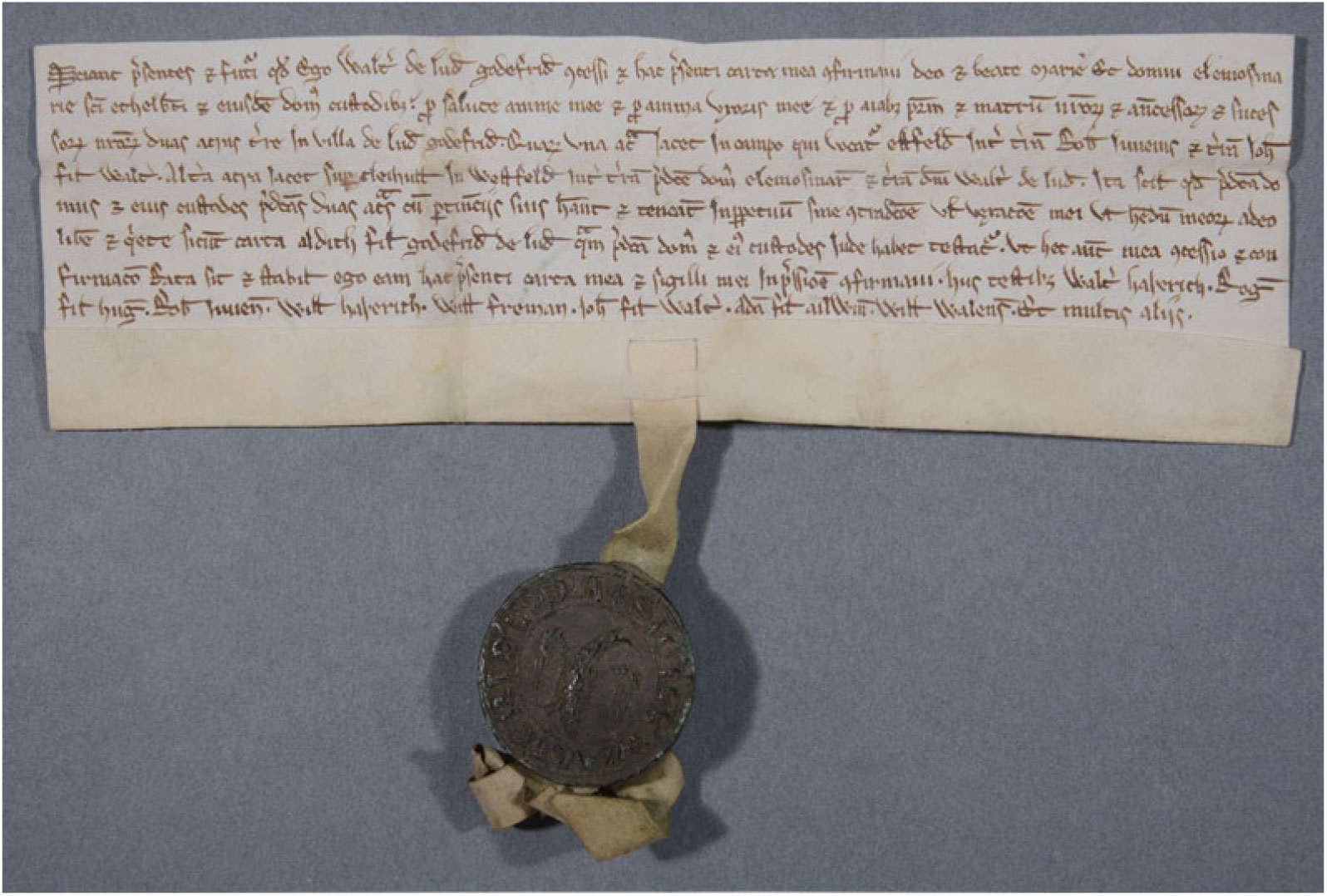
Fig 1a. Grant of Walter of Lyde Godfrey to the Hospital of St Ethelbert (HCA 821). Photograph: the authors.

Fig 1b. Grant of John, son of Walter, to the Hospital of St Ethelbert (HCA 832). Photograph: the authors.
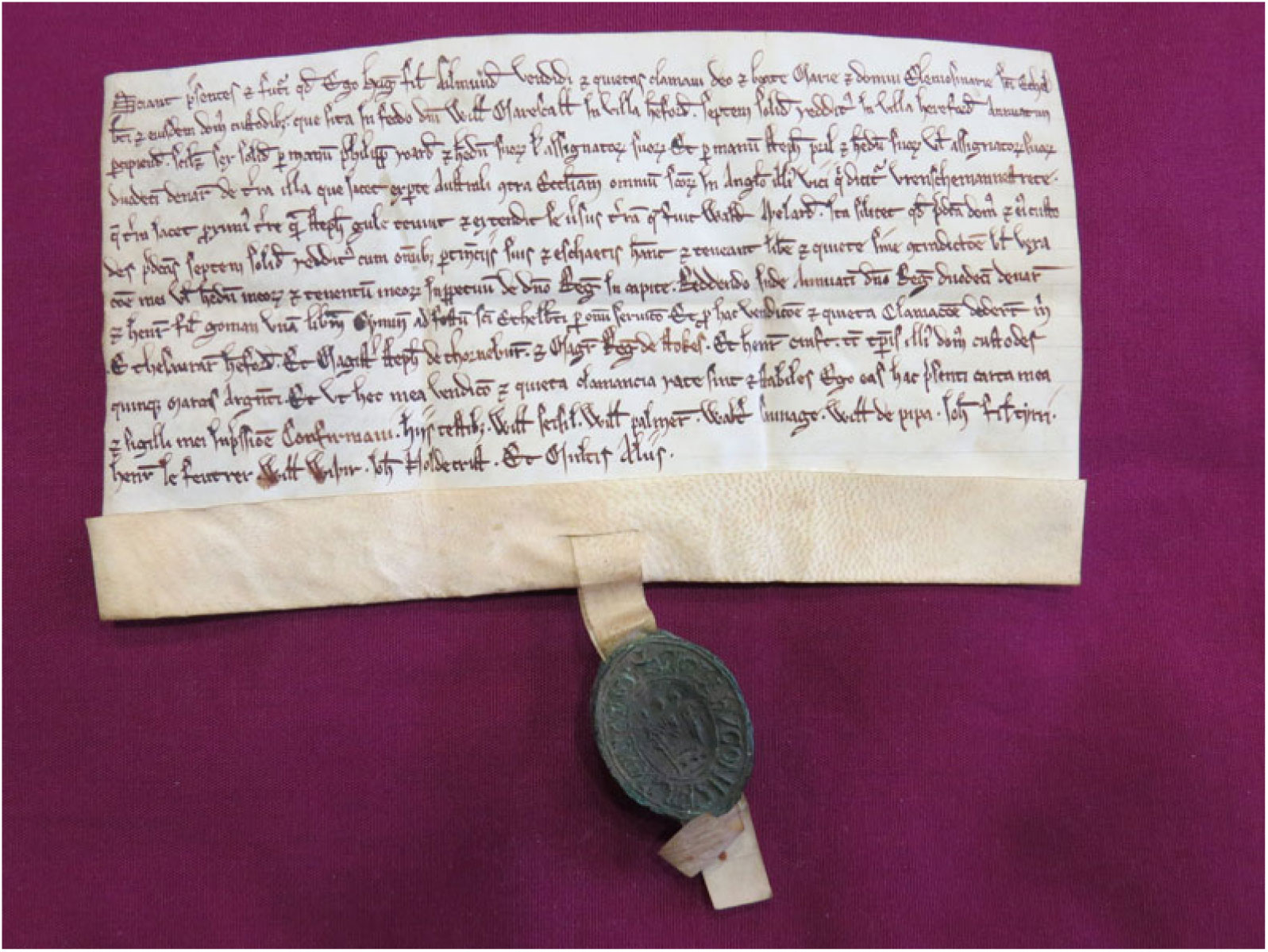
Fig 1c. Grant of Hugh, son of Ailmund, to the Hospital of St Ethelbert (HCA 861). Photograph: the authors.
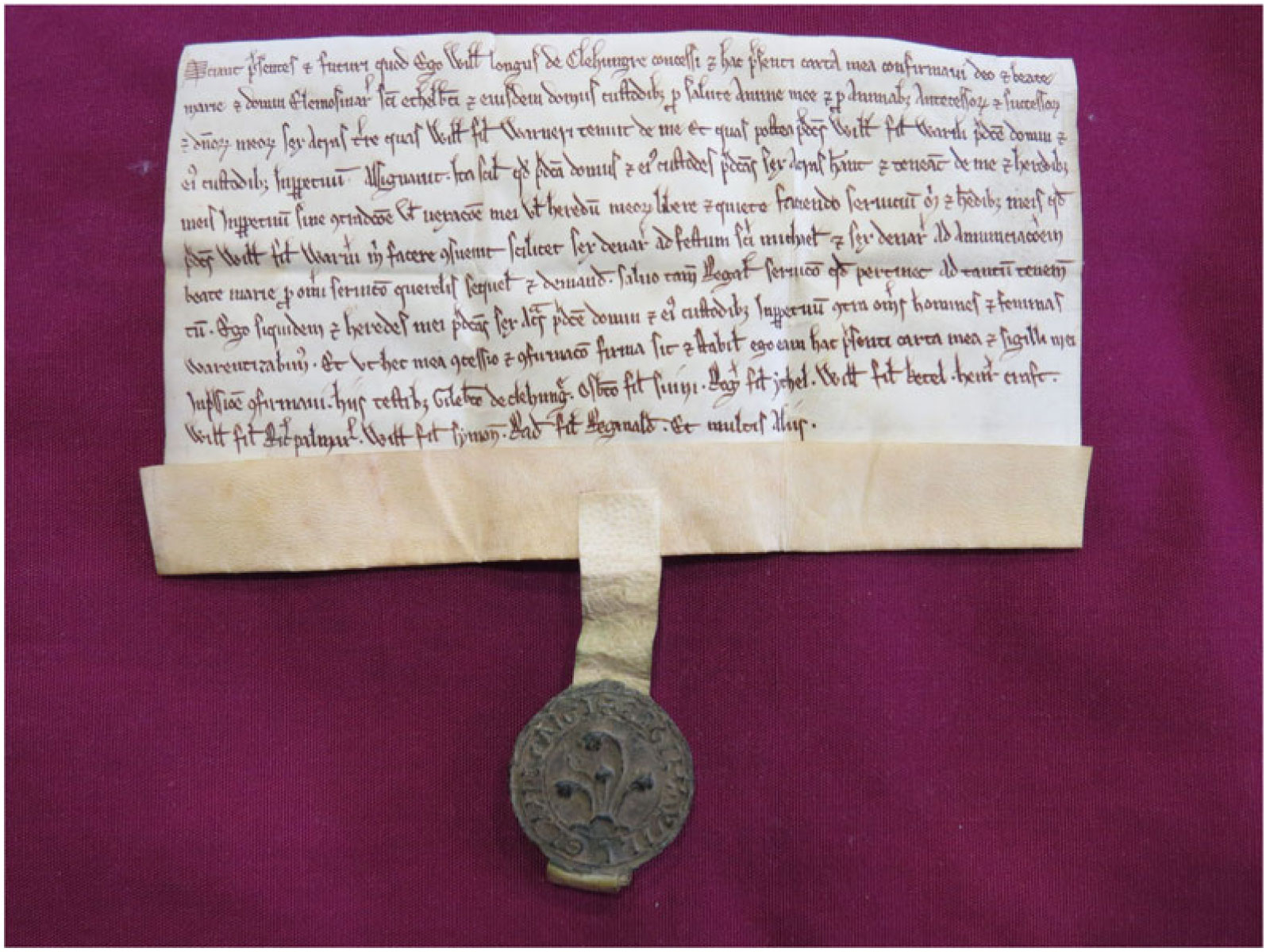
Fig 1d. Grant of William Long to the Hospital of St Ethelbert (HCA 915). Photograph: the authors.
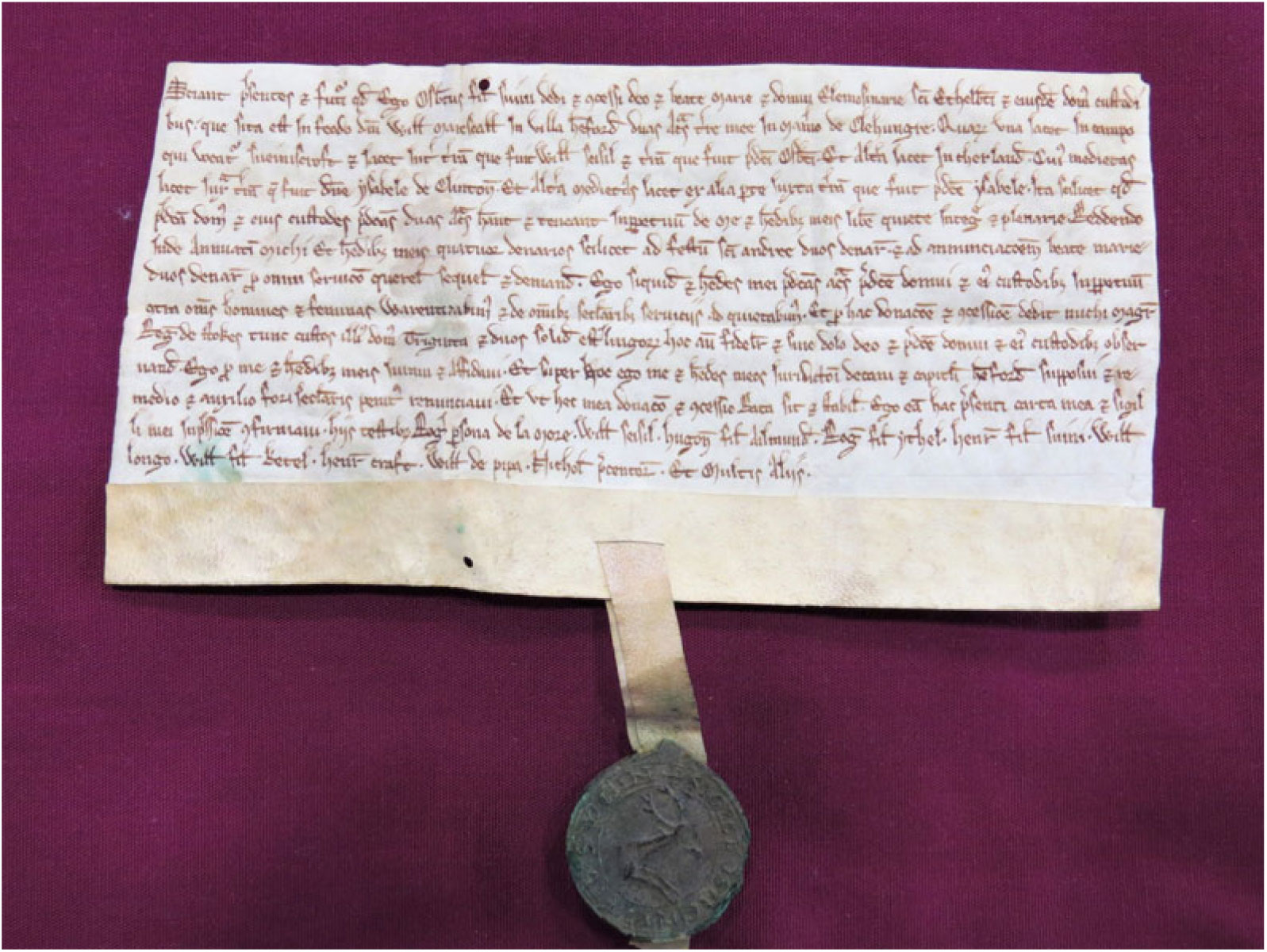
Fig 1e. Grant of Osbert, son of Suin, to the Hospital of St Ethelbert (HCA 929). Photograph: the authors.
Why did this occur? Some possibilities about the administrative process can be ruled out immediately. The seals were not necessarily affixed by either the scribe or the drafter of the document. These two individuals and the document’s sealer were usually three different people in ecclesiastical chanceries,Footnote 26 but even setting this aside it is clear that the documents under investigation are not all in the same hand, nor is the diplomatic close enough to suggest a single drafter. Although the looped ascenders of the lowercase ds, the shape of the majuscule S at the start of the documents, the noticeably upright lowercase f and the shape of the general abbreviation mark make it possible that the same scribe wrote the grants by Osbert, son of Suin, and Hugh, son of Ailmund, there are distinct differences in the letter forms between these and the other three documents: the majuscule M forms a contrast, for example, between the document of Hugh, son of Ailmund, and that of Walter of Lyde Godfrey. William Long’s charter includes a lowercase letter ‘d’ without a looped ascender and with a distinct majuscule E.Footnote 27 Neither are the documents’ diplomatic identical. Generally, they are standard in the way one would expect of private grants at this date, all beginning Sciant presentes et futuri quod ego, making use of the first-person singular, and containing very similar, though not identical, corroboration clauses. Overall, they reflect the phrasing of the many grants to St Ethelbert’s which survive for the second quarter of the thirteenth century. The description of the house varies, however. All the grants are made to the almonry, but only some of them elaborate their description of the hospital to make mention of its place on William Marshall’s fief. This is not an addition that adds to the particular charters under investigation, but instead seems to be a drafter’s choice of qualifier.Footnote 28
There is also no reason to think that these grants were made on the same occasion. They do not all concern land in one area: two certainly refer to land in the Lyde area, north of Hereford, in the field called Eastfield, and are presumably therefore close to each other,Footnote 29 but the remaining three parcels of land are in Clehonger to the west of the city, about ten miles from Lyde. Therefore, as a group of documents they are unlikely to be the result of a dispute settlement for the parcelling up and transference of large numbers of small parcels of land in one go, as perhaps part of a land exchange.Footnote 30 Nor do their witness lists suggest that they were all issued on one occasion (as is usual for private deeds of the first half of the thirteenth century, none have a dating clause). It is true that some of these grantors act as witnesses to each other’s grants within these five charters, but they do not do so consistently and no more than one of these five men witnesses any one of this group of charters. The remaining witnesses also differ. Men such as William de Pipe, Roger, son of Ythel, William Hatherich, William Freman and Henry Craft witness more than one of the documents, but never all five,Footnote 31 and some men, such as Roger, the parson of La More, appear only once.Footnote 32 These repeated witnesses are also commonly found in a whole range of documents issued in favour of St Ethelbert’s, both as witnesses and as grantors, their links being to the hospital as a whole.
Perhaps, then, the answer to the same individual’s prints occurring on all the wax seals lies in the networks, property and dwelling places of the individual grantors. Who were the five people who made these grants? Of some of them we know very little indeed. John, son of Walter, whose charter grants land in Lyde Godfrey to the almshouse with the agreement of his wife Christina, is not otherwise found in the hospital’s charters.Footnote 33 Osbert, son of Suin, is found only in this grant and one or two witness lists and must have died not far past the mid-thirteenth century: his widow, Agnes, quitclaimed five acres of Clehonger land from her dowry to the hospital in the middle of the century.Footnote 34
Others have left more of a trace in the records. Hugh, son of Ailmund, had long family connections within the Clehonger area. His father made a number of small grants of Clehonger property to individuals and institutions,Footnote 35 and his brothers, Ingeram and John, also witness charters and make their own grants of property in Clehonger.Footnote 36 Hugh appears as witness to charters across the first half of the thirteenth century, from around Clehonger and in the city of Hereford, including grants to the cathedral.Footnote 37 He also had property in the city and familial connections with the cathedral. In summer 1228 he was recorded on the fine rolls as one of the cancelled amercements of Hereford; he had owed one mark, and his pledge had been Henry Craft, one of the masters of the almshouse, with whom he had witnessed other people’s grants to the almshouse.Footnote 38 In addition, several members of his family appear in the Hereford obit book. Annora, described as the wife of Ailmund the miller, was remembered on 1 July for her gift of six pence, and Alan the miller, Hugh’s grandfather, was also recorded, under 24 August, for his gift of land worth six pence.Footnote 39
The document of William Long of Clehonger is among this group of five charters and confirmed a grant of six acres of land, which William, son of Warner, had held from William Long but had granted to the house of St Ethelbert’s.Footnote 40 William had land about six miles west of Clehonger, and was clearly active in the area in the 1230s making grants and witnessing charters.Footnote 41
The final grantor in this group was Walter of Lyde Godfrey, sometimes called Walter, son of Nicholas. Like John, son of Walter, his landholdings were in Lyde Godfrey (now known as Upper Lyde), to the north side of Hereford where Clehonger is to the west, and he too witnesses many charters in favour of St Ethelbert’s in the period 1225–50.Footnote 42
All five of these grantors, then, were men whose concerns were local, not national. They witnessed grants for each other and for other small local landowners, mainly in their own areas of influence, regularly appearing as both donors and witnesses in the surviving thirteenth-century grants to St Ethelbert’s Hospital, and having their grants witnessed by these men in turn. All of them must have been relatively well-to-do as they were landowners, albeit small landowners, and, as they were sought as witnesses to documents, would have been people of good legal standing.Footnote 43 They did not, as far as we can tell, share a common lord. The Devreux family were lords of Clehonger at this date, while Lyde Godfrey was held of the honour of Weobley from the de Lacy’s by Richard Feythou.Footnote 44 Their relationship with the cathedral itself was limited: none of them was obviously wealthy enough to make grants to that body that would have allowed them in a place in the Hereford obits, and they had little involvement with grants made directly to the Dean and Chapter.
If no obvious connections can be made between the drafter, scribe or principal party involved in the five documents under investigation, but one person handled the wax in each case, do the sealing practices and the physical imprinting of the matrix reveal any obvious association? As part of such an investigation it is also important to see if there are any discernible similarities or differences in the mechanical process of sealing (as far as can be determined from the extant material) in the instances where documents were validated by the same sigillant. In essence, without the print analysis, is there any way in which we can associate different sealers – the person who actually held the wax and impressed the matrix (assuming that they were one and the same) – with these five extant pendent seals?
Nothing that we can identify about the process of sealing these documents makes them a distinctive group. Indeed, in terms of documentary evidence there is, as would be expected in the first half of the thirteenth century, no indication that anyone other than the sigillant was involved in the actual act of sealing, and in each of the five cases the sealing clause is standard for the period and concludes sigilli mei impressione confirmaui.Footnote 45 All five documents with handprints from the same person on the wax are also sealed using a very similar shade of green wax and on a parchment ‘tag’, a strip of parchment threaded through the turn-up at the foot of the document, a common way of attaching a seal in medieval England and Wales and again, as was usual, they were on ‘clean’ rather than reused parchment.Footnote 46 In three instances (HCA 832, 915, 929; figs 1b, 1d, 1e) the wax has been attached quite low down on the tag in relation to its total length, but on the other two (HCA 821, 861; figs 1a, 1c) the wax has carefully been placed near the centre of the tag.Footnote 47 In all five cases there is, however, room for the seal impression to be folded up within the document, suggesting a familiarity with the preparation and storage of sealed instruments on the part of someone involved in process.Footnote 48 As with the form of attachment, the colour of the wax does not appear to be of note since wax of an almost identical shade was used quite frequently on documents relating to Hereford Cathedral and to St Ethelbert’s Hospital in the same period.Footnote 49 Moreover, from information currently available it seems as though green wax was a popular choice for sealing across England and Wales, especially in the thirteenth century,Footnote 50 perhaps because the pigment (verdigris) was easy to procure, or because it was noticed that uncoloured wax deteriorated more quickly than coloured wax.Footnote 51 In terms of the actual disk of wax into which the matrix was impressed, in all five instances the upper cake is thinner than the lower, but again this is extremely common and only in one instance (HCA 861) is the top cake thin enough to have started to come away as a result of movement from the tags, as the document and pendant seal has been handled over the centuries.Footnote 52
While it is impossible to reconstruct fully the actual impressing of the matrix into the soft wax, and adult palm prints do not change with age so no chronology of the seals is possible, some clues may be gleaned from the extant items. All five seals have name legends that correspond to the principal party in the document, and all have a small cross to indicate the start of the legend, the most common format for the inscription on seals of this date.Footnote 53 Impressions of matrices of this type are, typically, orientated with the central motif and/or the legend cross reasonably central to the attachment (the cross in the legend band typically being at 12 o’clock in relation to the motif). Of the five seals under consideration all are reasonably well positioned. In three instances the matrix has either not been aligned absolutely centrally to the tag or with the cross orientated slightly off-centre,Footnote 54 but this is not in itself a clear indicator that someone unfamiliar with the process of documentary sealing was holding a particular matrix. Affixing cakes of wax to a tag, moulding them to form a smooth disk ready to take an impression, and impressing a matrix in the correct position and removing it cleanly is rather more challenging than it might sound, and there are numerous examples of sealings, including those of officials or institutions, where there are some ‘faults’ in the impression.Footnote 55 Without the handprint evidence, the discrepancy in the accuracy of attaching the wax or impressing the matrix might suggest to the researcher that different people may have been involved in the sealing process.
One final point to consider is whether anything about the matrices used could suggest a point of commonality. This is of course extremely difficult to determine in the absence of the actual objects, but the surviving impressions provide some clues. One of the fives matrices in the set, that of Hugh son of Ailmund, was of the ‘ancient gem’ type, with a carved seal-stone set into a metal mount (fig 2a).Footnote 56 The central motif depicts three figures with an object at their feet, an image which, it might be suggested, could have been interpreted by a medieval viewer as a Christian motif, perhaps the shepherds adoring the Christ-child.Footnote 57 Setting seal-stones, especially genuinely ancient items, into a metal mount required a skilled artisan, and such matrices are usually considered an indicator of some degree of, or aspiration to, wealth or status.Footnote 58 This fits with what else we know about Hugh and his family, as discussed above, although it is possible that the matrix was also an heirloom of some sort, for the impression suggests that the legend may have been re-engraved.
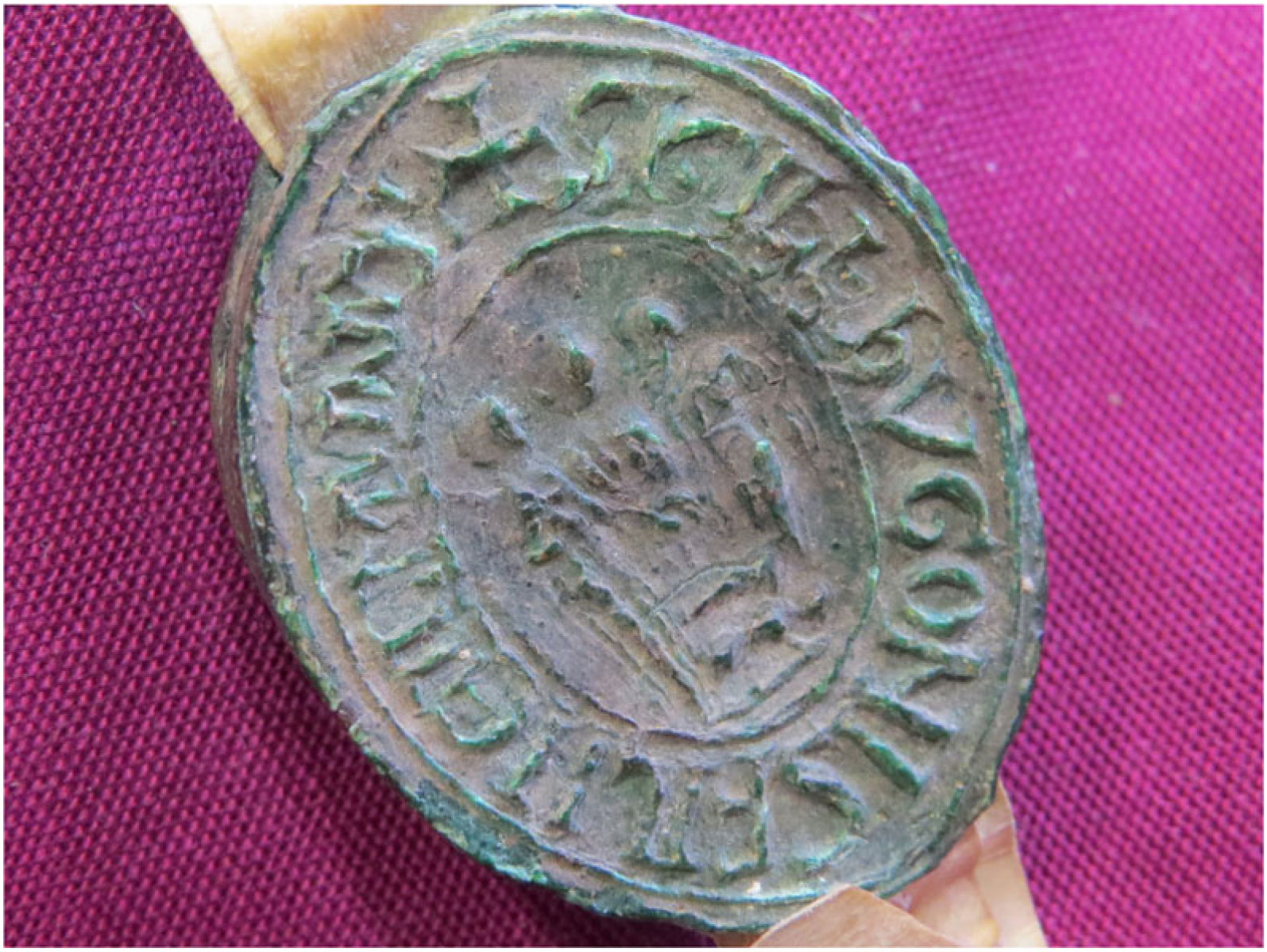
Fig 2a. Impression of the seal of Hugh, son of Ailmund (HCA 861). Photograph: the authors.
The four other matrices in this set all appear from the extant impressions to have been made from a single element, almost certainly metal at this date.Footnote 59 Three are round and one a pointed oval, and all have the standard format of a central motif surrounded by a name legend. Each has a different image, standard in the sense that the generic type of motif is found on numerous other seals of this period, but in three cases with variants that make them stand out and which suggest that seal owners in thirteenth-century Hereford had a choice of supplier when choosing their matrix. The seal of Walter of Lyde Godfrey depicts a bird with wings outstretched and its head turned back (fig 2b), a reasonably popular motif in this part of Britain at this time;Footnote 60 the impression suggests a matrix engraved by someone familiar with the process in terms of the placing of the image within the field and spacing of letters in the legend band. At first glance, the seal of John son of Walter is also quite typical for its time and place, with the motif of a stylised lily (fig 2c).Footnote 61 Very unusually, however, emerging from the central floret of the lily is a small trefoil. This appears to be a quite deliberate feature which, from the impression, seems to have been carefully engraved, and it is tempting to speculate whether John requested something to distinguish his seal from that of numerous others with a similar motif in a manner similar to the way in which marks of difference were beginning to be incorporated into armorial bearings in this period.Footnote 62 The seal of William Long has as a central motif stylised foliage, once again a reasonably common image but executed in an unusual manner (fig 2d).Footnote 63 Moreover, the fine engraving indicated by the impression and the rather ‘fleshy’ trefoil terminals of the foliage are very similar to those found on a number of other seals impressed on St Ethelbert and Hereford Cathedral documents of this period, hinting at an accomplished seal-maker operating within the city.Footnote 64 Finally, the seal of Osbert, son of Swein, has as a motif the head and front legs of a stag at full gallop – a dynamic and striking image (fig 2e).Footnote 65 Stags are found on a number of thirteenth-century seals across England and Wales, and the stag head full-face (caboshed) remained a popular sigillographic motif throughout the Middle Ages, but the form on Osbert’s seal is unusual. This is the only instance, apart from the seal of Hugh, son of Ailmund, where we have additional information from the impression about the form of the matrix, for part of the handle-loop at the top of the matrix was impressed into the wax. This also makes it somewhat surprising that this is one of the examples where the matrix was impressed off-centre to the wax cakes and tag, since the handle-loop would presumably have assisted the sealer correctly in orientating their matrix.
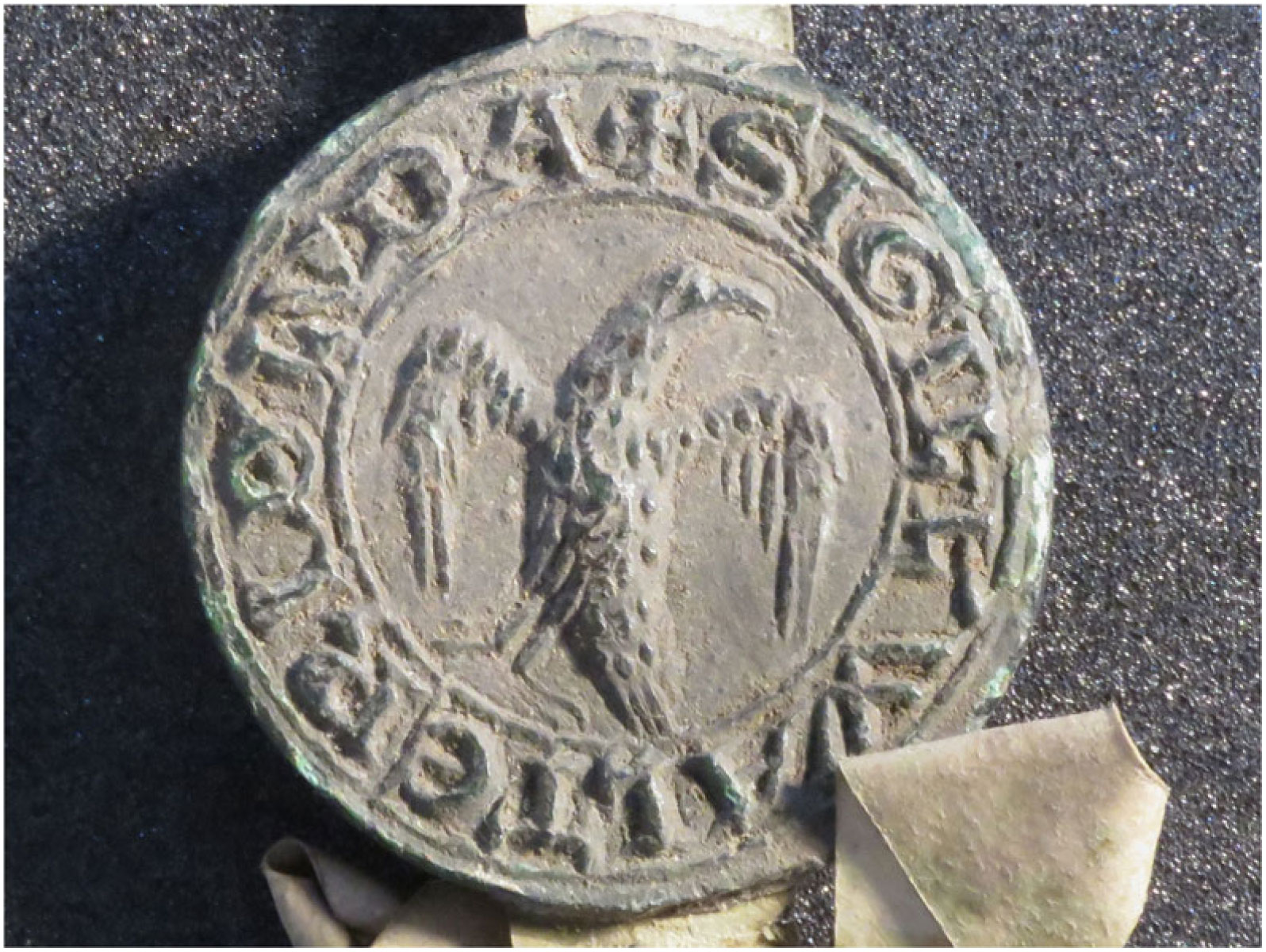
Fig 2b. Impression of the seal of Walter of Lyde Godfrey (HCA 821). Photograph: the authors.
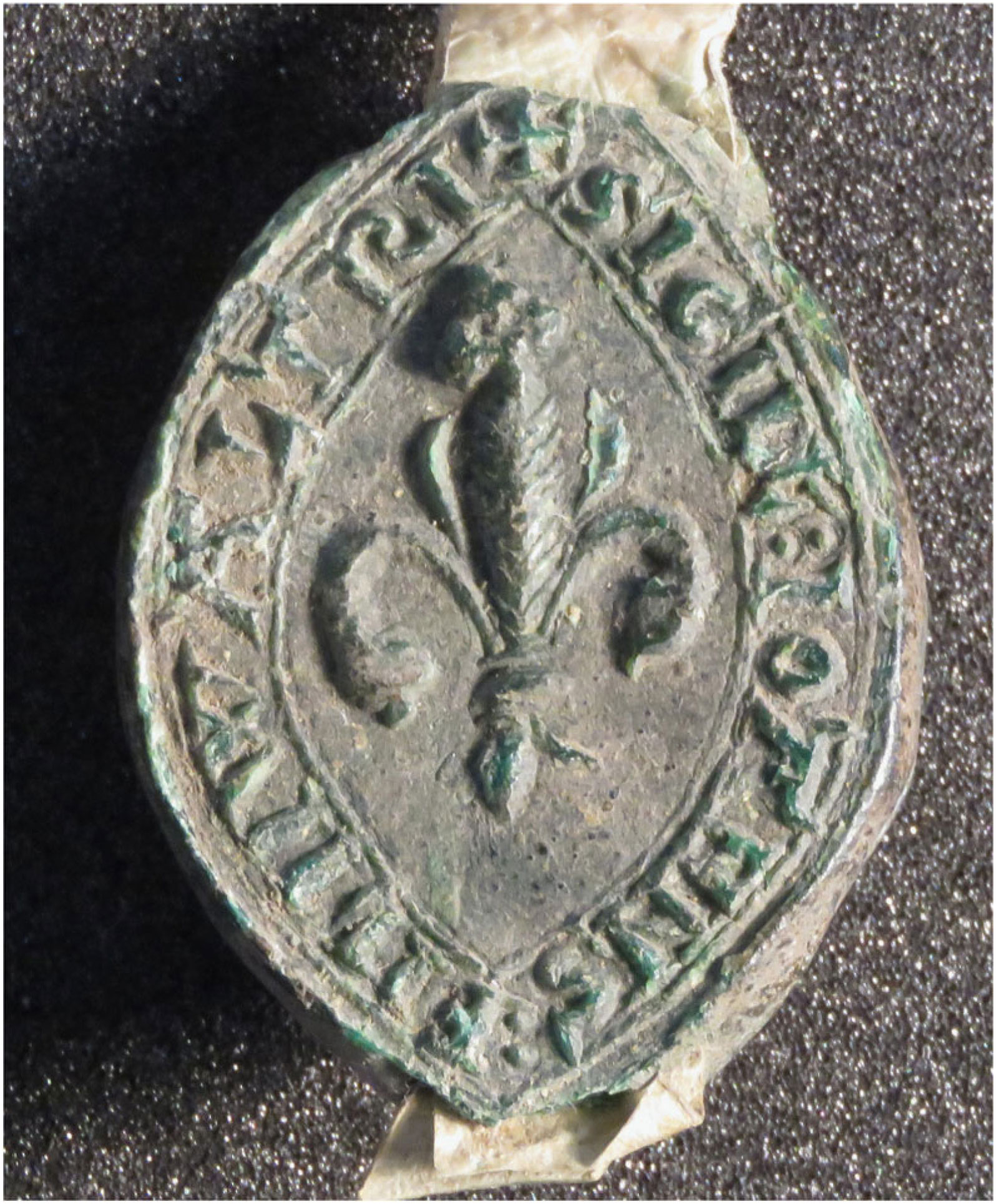
Fig 2c. Impression of the seal of John, son of Walter (HCA 832). Photograph: the authors.
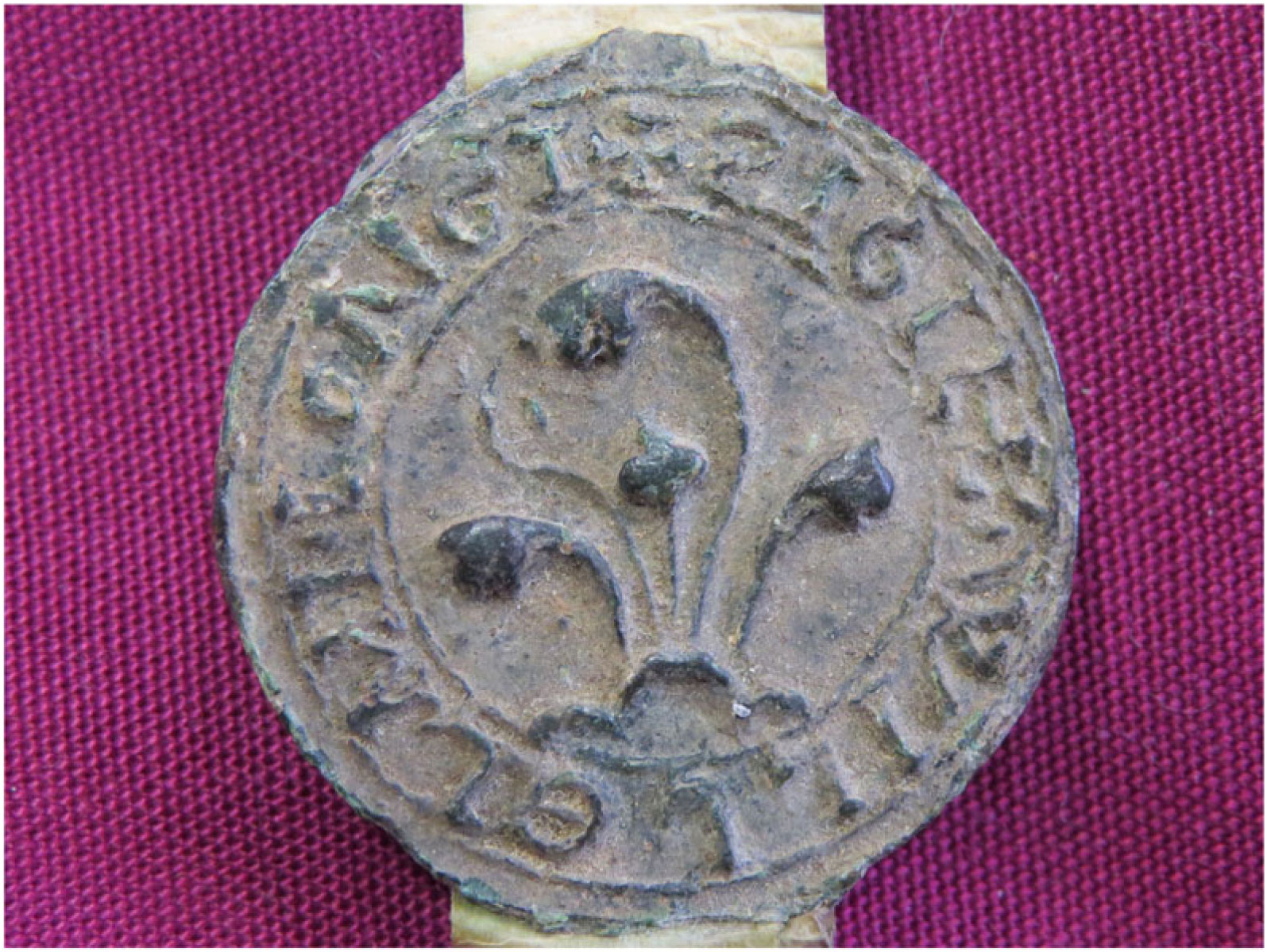
Fig 2d. Impression of the seal of William Long (HCA 915). Photograph: the authors.
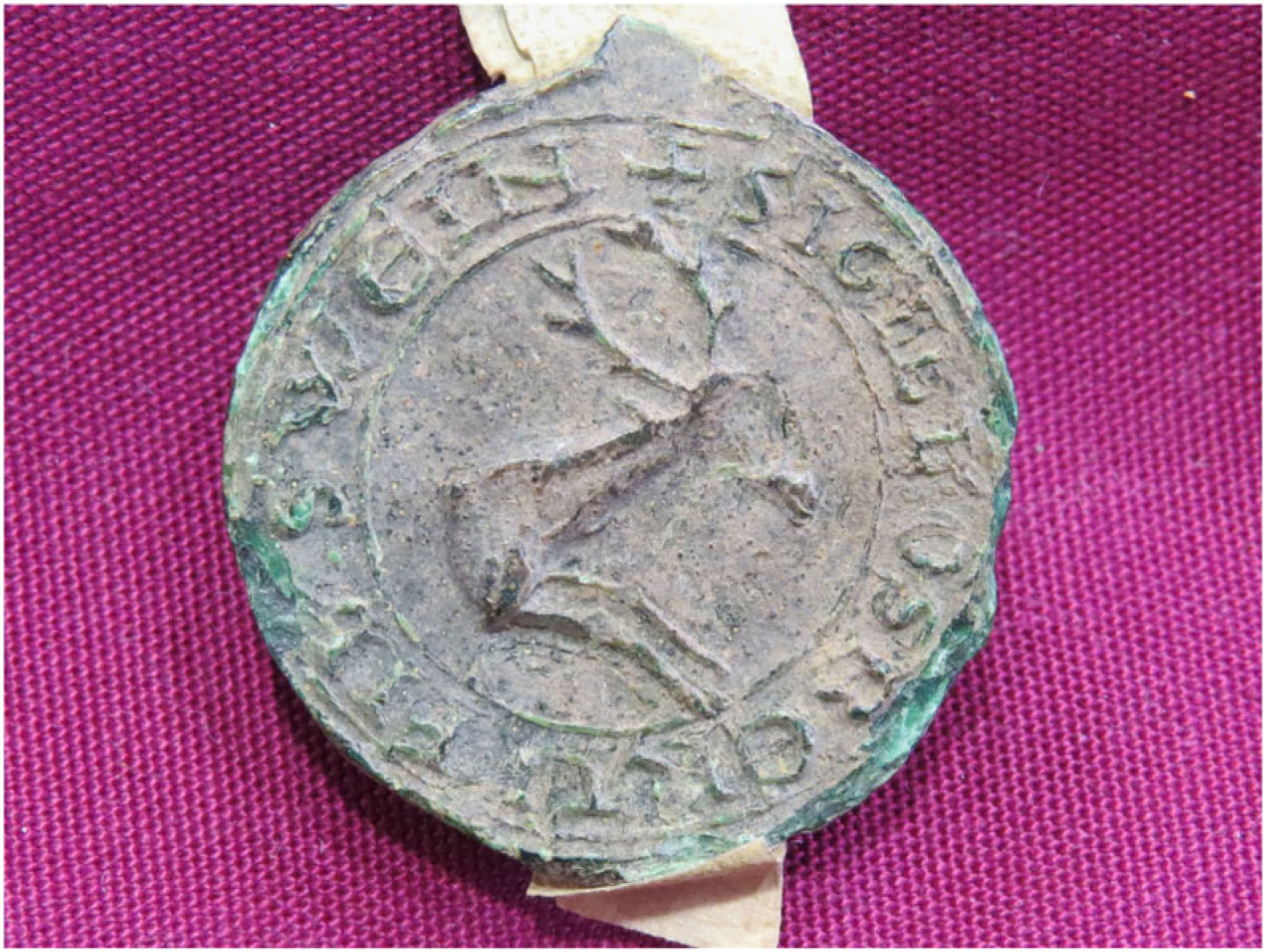
Fig 2e. Impression of the seal of Osbert, son of Suin (HCA 929). Photograph: the authors.
Without an investigation of the handprints on the wax, there would be nothing to indicate that the same person was involved in the physical act of impressing the matrix in the five items under investigation. The images and what we can tell of the matrices suggest men of a certain status with access to engravers producing high quality goods, but they do not link one sigillant to another. There is, then, no clear connection between the five sealed documents focused upon in this paper in terms of their construction or sealing. This in itself raises a number of challenging questions about how we investigate the documentary production, the development of clerical practice and, perhaps most importantly, how far we can rely on what contemporary records and modern assumptions reveal about the process of sealing. Nothing about the diplomatic or script of the grants suggests a single scribe or drafter was involved. Nor is there anything individual or particular about the sealing. There is no reason to assume that these documents were drafted or written at one time by one group of people, nor is there any clear link between the grantors or any coherence in the property they grant. The only evidence linking the sealing of the documents is the single palm print found on the reverse of each disk of wax.
The remaining most probable hypothesis, then, must be that the seals were attached by a single individual, who was connected with the only obvious link between the grants: their recipient, the Hospital of St Ethelbert. This individual was clearly confident with sealing: there are no obvious errors in his practice and slight mis-alignments of the matrix may speak to speed and the need to work efficiently rather than to any uncertainty about the process of impressing the matrix. However, in the broader context of other documents also issued for St Ethelbert’s in this period, it is clear that, if the hospital was providing someone to take a part in the sealing practice, then that was not always the same person. Of the other documents examined by the project of the same quarter century for St Ethelbert’s, nineteen provided exceptionally clear palm prints, and all nineteen of those prints are unique.Footnote 66 Nor does this imply that in these cases the grantor was taking full control over the sealing process: there is more than one instance of two documents issued by the same individual having clear but different prints.Footnote 67 We can see, then, the traces of an institutional practice of sealing that involves someone other than the grantor whose matrix is being affixed but where that third individual is regularly changing. A broader context suggests that these developments in sealing reflect other processes in thirteenth-century document production, and that they tell us something about document production for St Ethelbert’s Hospital in Hereford in particular.
The number of prints found on this collection of seals suggests that it is unlikely St Ethelbert’s were making use of their own chancery. By the thirteenth century, these sorts of documents, particularly issued in the names of moderate status secular individuals with no writing offices of their own, would have been recipient productions. In the 1230s, we know the house was made up of a custos and three brothers,Footnote 68 yet across twenty-five years we know at least seventeen people were involved in sealing of documents and even a brief glance at the hands of the documents to which the seals are attached suggests that they too include a considerable number of scribes. Even allowing for changes in personnel, this seems a large number for such a small house. There was, however, a larger institution very close to the hospital whose resources they could make use of. The hospital was adjacent to Hereford Cathedral, and its founder was a canon giving them an even closer link. Among the medieval charters it is clear that the property of the two institutions were sometimes confused, suggesting that the administration of the two organisations was not always kept separate,Footnote 69 and the fact that the St Ethelbert deeds now form a part of the archive of the cathedral is also suggestive. It is very probable that the hospital made use of the nearby Dean and Chapter chancery when documents needed to be written, a chancery which, in the thirteenth century, would have been extensive. In this context, the prints upon the wax are likely to belong to the person responsible for preparing the wax and attaching it to the parchment tag for the impressing of the matrix. This would be the equivalent of the royal chancery’s chafewax, although in the still developing chancery at a thirteenth-century cathedral it is likely that this was not a role attached to just one individual.
That suggests a close relationship between the cathedral and the hospital, which could have been thought of as a daughter institution. However, the handprint evidence also allows us to look at the process of sealing in conjunction with other developments in thirteenth-century document production. First, it ties developments in the Dean and Chapter’s administration to those in contemporary episcopal chanceries. The first half of the thirteenth century provides the earliest evidence of English bishops’ chanceries taking overall charge of formal episcopal sealing. That is, we begin to see a separation between the bishop in person and his legal authority as expressed by the affixing of his seal, with sealing undertaken by a professional as part of the administrative process of document production.Footnote 70 This is all the more probable as in general the process of document creation, particularly for grants of land and rights, was, by the 1230s, changing in England. Although in the 1240s, the legal expert known as Bracton was still asserting that the process of granting land must be a physical one, taking place on the property itself, with the document only secondary, it is clear even in his assertion of this position that the document had become primary and that it, like the physical grant, was a tangible embodiment of the donor’s agreement to this process, not just a record of it.Footnote 71 We might think that this change should make little difference to sealing: as a seal became part of this demonstration of the will, surely the donor’s part in attaching the seal would have become even more important. Yet, the effect that this change reflected in the document’s production would also affect sealing. The document and the event itself were becoming distinct from each other, as Davit Broun has noted happens in the production of witnesses. Witnessing the production of a document and witnessing the completion of the transaction through a particular ceremony become different elements in the 1230s, with few witnesses appearing to have been present for the document’s writing.Footnote 72 Witnesses, like seals, were validatory parts of the document. As it was possible for these evidences of validation to become separated from the performative aspect of the grant, meaning that witnesses were no longer necessarily those who had been present on site for the ceremony of livery of seisin, so it was not necessary for that other validation, the sealing, to be closely connected to the same ceremony by being performed only by the individual sigillant. In fact, it may not have been necessary for all seals to be added to a document at the same time: in at least two thirteenth-century instances at Hereford, multiple seals on one document provided different prints.Footnote 73 The most probable reason for this is that the seals were attached at different times, and the wax was provided for each individual seal, sealing was therefore prepared and held by different people.
An administrator, then, took a part in the sealing by holding the wax; separating in at least some instances the wax that received the imprint of the seal matrix from the physical presence of the sigillant. None of the St Ethelbert’s sealing clauses, it should be noted, say that the grantor has affixed their seal, just that they have confirmed the grant through its impression. An argument from the use of standard phrases is not difficult to make, and may reflect the diplomatic preferences of the chancery, but affixi was also commonly found in charter corroborations and the choice of verb may be significant. It is by no means certain, however, that the grantors played no personal role in the impressing of their matrices. Almost certainly they would have been present – there is no reason to assume that they would have been long separated from their matrices: the only secular evidence we have of this sort of separation is for an official matrix,Footnote 74 and those attached to the grants to St Ethelbert’s are personal. There is also reason to think that they may still have been responsible for impressing the matrix. We have already noted that the document had become a physical embodiment of the donor’s consent to a grant. Attaching an individual’s seal without consent was enough to invalidate an agreement: in 1293, at the Common Bench, the monks of the priory of St Swithin’s, Winchester, were able to argue that the affixing of their seal to a bond was invalid because it had been done without their agreement.Footnote 75 How would a donor’s consent to sealing be recognised? The handing over of their matrix to an administrator may, just possibly, have been enough. They may also, though, have been expected to play a more active part, even if only in the presence of administrative officials. While one person held the wax, another could be responsible for impressing the matrix into it. Brand has noted an instance in the late thirteenth century when a reluctant female sigillant, Maude de Clovile, who claimed lack of expertise with sealing in her attempt to resist making land over to her father, was not forced to prepare the wax or to impress the matrix, but by removing the matrix herself she retained an involvement in the process, and her only partial involvement could have been connected both to her reluctance to consent to the sealed instrument and to her disavowal of the matrix itself (prepared for her by her father).Footnote 76 At Hereford, if we look forward to the fourteenth century, we can see practices that must demonstrate the sigillant’s active involvement in sealing. The impression of knuckles, or even a thumb (for example, into the reverse of the wax), served no purpose of validation, but would have been a very visual way of signifying the seal owner’s consent to the process, comparable to twelfth-century impressing of hair within the wax.Footnote 77 Even where administrative process had taken over, a donor could be expected to be involved in the affixing of their own matrix.
CONCLUSIONS
The evidence of palm prints on the wax seals of thirteenth-century grants to St Ethelbert’s Hospital, Hereford, demonstrates that administrative developments have, by this point, intervened between the owner of the matrix and the sealing of the document. It is clear that the grantor named in the documents was not always the individual responsible for attaching their seal to the document. There are occasions upon which both disparate seals share a print, and when two waxes with impressions of the same matrix have different prints; too many occasions to be explained by chance. This separation must be explained by the development of an administrative process, with a member of a chancery (in this case probably that of the Dean and Chapter at Hereford), who would have been needed to prepare the wax for sealing, taking a part in the impressing of the matrix by holding the wax seal. This intervention of an administrator between the matrix holder and the document which embodied their will in their grant suggests that the seal, like that other validatory element of the charter, the witness list, was becoming detached from the performance of livery of seisin in thirteenth-century England. This does not, however, necessarily mean that the donor now played no part in the sealing. While in the thirteenth century they left no mark on the wax, and so we cannot be certain whether the sigillant impressed their own matrix, seals of the fourteenth century related to cathedral documents include marks from knuckles and thumbs, which have no practical purpose and are reminiscent of earlier practices, such as the embedding of hair in the wax.Footnote 78 While the matrix, then, was certainly still a part of the sigillant’s identity, the sealed wax was both more and less than that.
ACKNOWLEDGEMENTS
The authors would like to thank Professor Phillip Schofield for his helpful comments on a draft of this article, and Professor Brigitte Bedos-Rezak, Professor Paul Harvey, Dr John McEwan, Dr Markus Späth, Professor Nicholas Vincent and Professor Tessa Webber for discussions about and advice on aspects of the underpinning research. The authors are also grateful to Mrs Rosalind Caird and the Reverend Canon Chris Pullen at Hereford Cathedral, and to Luke McGarr and Dr Karen Stow at Forensic Focus Ltd for their support for and assistance with the 2013 project, and the University of Lincoln for funding that project.
ABBREVIATIONS & BIBLIOGRAPHY
Abbreviations
- AHRC
-
Arts and Humanities Research Council
- HCA
-
Hereford Cathedral Archives














